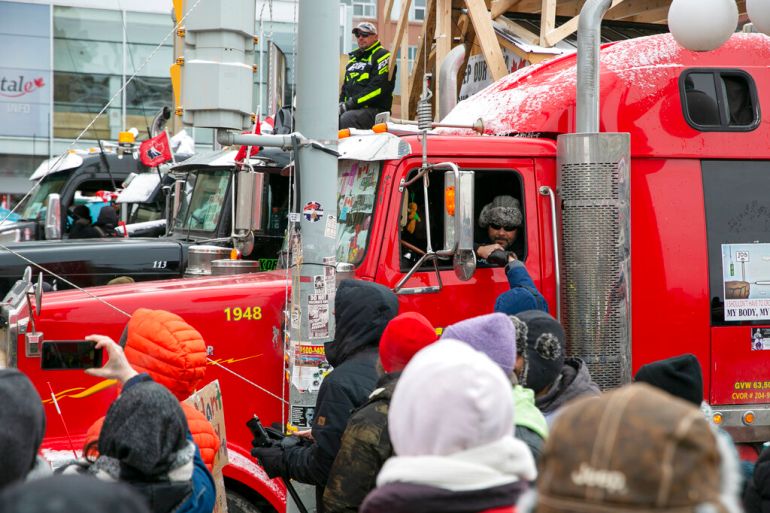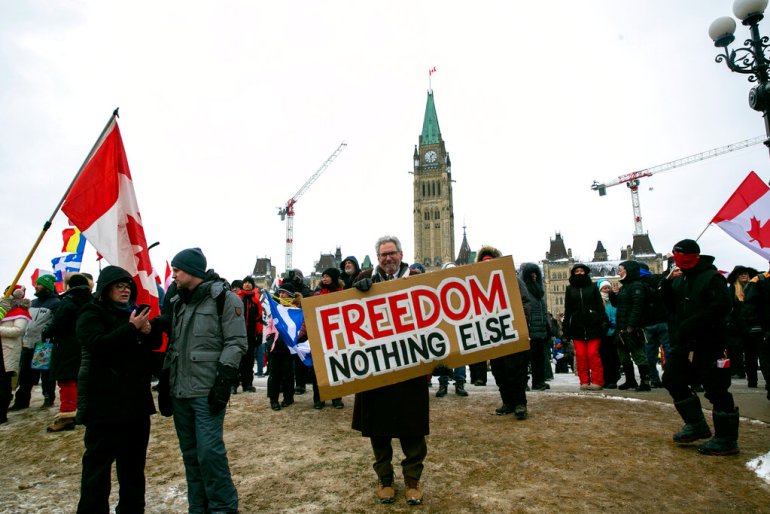Ontario drops vaccine proof, Canada trucker protests persist
Busiest US-Canada border crossing is re-opened, but protests in Ottawa swell as authorities struggle to gain control.

Ontario’s premier announced on Monday that Canada’s most populous province will lift its COVID-19 proof-of-vaccination requirements in two weeks — not because of the protests that have blocked the border and paralysed Ottawa, he said, but because “it is safe to do so.”
The busiest US-Canada border crossing, meanwhile, was open again on Monday after police removed the last of the protesters who had bottled up the Ambassador Bridge for nearly a week in a demonstration against Canada’s virus restrictions. But the larger truck-borne protest in the capital, Ottawa, persisted as city residents seethed over authorities’ inability to reclaim the streets.
Keep reading
list of 4 itemsLatest Canada updates: Police clear protesters occupying bridge
Canada’s capital is being held hostage by extortionists
What’s fuelling Canada’s trucker protest?
Ontario Premier Doug Ford said that on March 1, the province will drop its requirement that people show proof of vaccination to get into restaurants, gyms and sporting events. A surge of cases caused by the Omicron variant has crested in Canada.
The province will also remove its 50-percent capacity limit on restaurants on Thursday, four days earlier than planned. Ford gave no timetable for dropping the requirement that people wear masks in public places.
“Let me be very clear: We are moving in this direction because it is safe to do so. Today’s announcement is not because of what’s happening in Ottawa or Windsor, but despite it,” Ford said.
Ford said he would support Prime Minister Justin Trudeau’s government if it proposed further measures to quell the protests.
“We need law and order. Our country is at risk now. It’s not just happening here in Ottawa, but it’s happening in Alberta and British Columbia,” Ford said. “We won’t accept it.”
Trudeau planned to meet virtually with the leaders of Canada’s provinces on Monday morning, as well as with lawmakers.
The prime minister has so far rejected calls to use the military but has said “all options are on the table” to end the protests including invoking emergency measures. Trudeau has called the protesters a “fringe” of Canadian society. Both federal and provincial politicians have said they cannot order police what to do.
Demonstrations against virus restrictions and other issues have bottled up several crossings along the US-Canada border and hurt the economies of both nations. They also inspired similar convoys in France, New Zealand and the Netherlands. US authorities have said that truck convoys may be in the works in the United States.
Police in Windsor arrested about 30 protesters and towed several vehicles Sunday near the Ambassador Bridge, which links Windsor – and numerous Canadian auto plants – with Detroit. The bridge, which carries 25 percent of all trade between the two countries, reopened to traffic late Sunday night.
After protesters began blocking bridge access February 7, automakers began shutting down or reducing production at a time when the industry is already struggling with pandemic-induced shortages of computer chips and other supply-chain disruptions.
“Today our national economic crisis at the Ambassador Bridge came to an end,” Windsor Mayor Drew Dilkens said on Sunday.
About 750 km (470 miles) northeast of Windsor, the protest in Ottawa has paralyzed downtown, infuriated residents who are fed up with police inaction and turned up pressure on Trudeau.
The city had appeared to have reached a deal in which protesters, who have jammed downtown streets with trucks and other vehicles for more than two weeks, would move out of residential areas and confine their demonstrations to the Parliament Hill area, but those prospects soon faded.
In a letter to the protesters, Ottawa Mayor Jim Watson said residents are “exhausted” and “on edge” because of the demonstrations, and he warned that some businesses are on the brink of permanent closure.
“It’s stressful. I feel angry at what’s happening. This isn’t Canada. This does not represent us,” said Colleen Sinclair, a counter-protester who lives in Ottawa.
Sinclair said all demonstrators have had their say and need to move on – with police force if necessary.
“They’re occupiers,” she said. “This is domestic terrorism, and we want you out of our city. Go home.”
While the protesters are decrying vaccine mandates for truckers and other COVID-19 restrictions, many of Canada’s public health measures, such as mask rules and vaccine passports for getting into restaurants and theatres, are already falling away as the Omicron surge levels off.
Pandemic restrictions have been far stricter in Canada than in the US, but Canadians have largely supported them. The vast majority of Canadians are vaccinated, and the COVID-19 death rate is one-third that of the United States.

A judge on Friday ordered an end to the blockade at the Ambassador Bridge, and Ford declared a state of emergency allowing for fines of $100,000 Canadian and up to a year in jail for anyone blocking roads, bridges and other critical infrastructure.
Michigan Governor Gretchen Whitmer welcomed the end of the blockade as “a win for Michigan’s working families who are just trying to do their jobs and for businesses who can get back to shipping their products and produce”. She added: “It’s important to ensure that this does not happen again.”
Michigan officials estimate that 10,000 commercial vehicles cross the bridge each day with $325m of goods, approximately $50m from automotive parts.
The Windsor protest began to dwindle Saturday after police persuaded many protesters to remove vehicles blocking the road to the bridge. But in Ottawa, Saturday’s crowd swelled to what police said were 4,000 demonstrators, and a counter-protest of frustrated Ottawa residents attempting to block the convoy of trucks from entering downtown emerged Sunday.